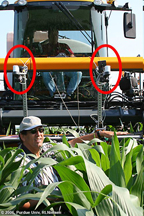

August 8, 2008
Purdue experts leave nitrogen detection to optical reflectance sensors
WEST LAFAYETTE, Ind. - |
The soils' ability to supply nitrogen is dependent on the amount of organic matter, drainage capability, rainfall, soil temperature, mineralization potential, leaching potential and denitrification potential, said Jim Camberato, Purdue Extension soil fertility and plant nutrition specialist.
Camberato and Bob Nielsen, Purdue Extension corn management specialist, conducted trials over two years at seven Purdue research farms, 39 sites with a corn-after-soybean rotation and 18 sites with a corn-after-corn rotation.
"After conducting nitrogen rate trials in '06 and '07, we found the optimum nitrogen fertilizer rate is not strongly related to yield potential," Nielsen said. "Or it could be said that higher yielding fields don't necessarily require higher nitrogen fertilizer rates.
"There was, however, an excellent relationship between relative yield in each field and the total nitrogen available to the crop, which is the nitrogen the soil supplies plus the fertilizer. In some cases more than half of the nitrogen supplied from the crop originated from the soil itself."
Camberato said when the new data is plotted out, yield plateaus at about 275 pounds per acre of soil plus fertilizer nitrogen.
"This means if we know how much nitrogen the soil supplies, we can subtract that amount from 275 and know how much additional nitrogen the plant actually needs," Camberato said. "But predicting the amount of nitrogen supplied by the soil is difficult."
The fact that the nitrogen cycle is dynamic, mineralization rates are hard to predict, rates of nitrogen loss are hard to predict and required weather data is hard or costly to obtain, all make it hard for a successful model to be developed, Camberato said.
Despite the challenges, Purdue University agronomist Brad Joern is working to develop a model that will estimate up-to-date mineralization and nitrogen loss variables.
Until then, optical reflectance sensors can be used to measure light reflectance from leafy crop canopies, which can be used to estimate the nitrogen status of plants and ultimately estimate how much additional nitrogen needs to be applied. Healthy, large plants reflect light differently than struggling, smaller plants and plants with adequate nitrogen reflect light differently than nitrogen deficient plants.
"Optical sensors helps us recognize and quantify differences in the nitrogen content of plants in areas of a field," Camberato said. "The nitrogen rate can be controlled manually or electronically to change application rates based on reflectance differences in a field."
There are two primary commercialized sensors in use in the United States, Crop Circle™ and GreenSeeker™, Nielsen said. Both units emit near infrared rays and visible light wavelengths.
Nielsen and Camberato said there are three rules to remember when working with optical reflectance sensors.
The first is optical sensor measurements and nitrogen content of corn relate best once the crop is well into its rapid growth phase, the V8 stage and beyond where approximately 60 percent of nitrogen uptake occurs. The uptake of nitrogen during the rapid growth phase is dramatic and differences in plant nitrogen levels become more evident to the human eye and especially to optical sensors.
"The down side of waiting to apply nitrogen after the V8 growth stage is that the corn plants are much taller, which limits the technology to operations that can apply fertilizer through irrigation water or with high clearance applicators," Camberato said.
Second, growers need to include a high-nitrogen reference strip for each hybrid in each field. These strips are used to help drive the predictive formulas for the sensors. Because hybrids vary naturally in their "greenness," the sensor will need to be recalibrated for each one, Camberato said.
Third, not all low reflectance areas in a field are simply nitrogen deficient. Low reflectance areas within a field need to be carefully interpreted by the operator or the sidedress applicator if the intent is to vary nitrogen rates on a site-specific basis. It's important to keep in mind that not all low reflectance areas will be "no-brainers" like drowned out spots, Nielsen said.
Writer: Julie Douglas, (765) 496-1050, douglajk@purdue.edu
Sources: Bob Nielsen, (765) 494-4802, rnielsen@purdue.edu
Jim Camberato, (765) 496-9338, jcambera@purdue.edu
Ag Communications: (765) 494-2722;
Beth Forbes, forbes@purdue.edu
Agriculture News Page
Caption: Optical reflectance sensors attached to a high-clearance sprayer measure corn's nitrogen level.
To the News Service home page
